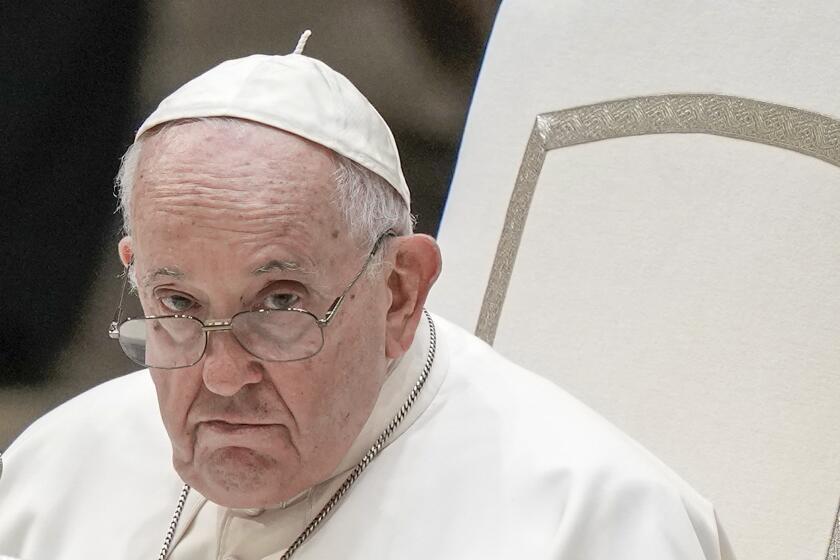Casey Pushed for Arms Sales to Iran : Spy Chief Pressed Use of Middleman Who Had Failed CIA Lie Detector Test
- Share via
WASHINGTON — The CIA gave Iranian arms dealer Manucher Ghorbanifar a lie detector test in 1985 before the Reagan Administration used him as a go-between in trading arms for hostages--and Ghorbanifar failed, Administration officials and congressional sources said Friday.
“The agency considered him a chronic liar,” said a source familiar with the CIA’s testimony before congressional committees this week. “The CIA had been dealing with Ghorbanifar . . . (and) completely distrusted him.”
Nevertheless, CIA Director William J. Casey decided that selling arms to Tehran through Ghorbanifar was a good idea, and he promoted the idea energetically in the secret councils of the Administration, sources said.
In his talks with Administration officials, Ghorbanifar repeatedly promised to arrange the release of all American hostages held by pro-Iranian terrorists in Beirut if the United States would send weapons to Iran. But, each time the United States approved a shipment of arms, only one hostage was freed--and the Iranians demanded still more weapons.
‘Second Thoughts’
“They knew at the beginning that Ghorbanifar was unreliable,” a knowledgeable official said. “It was almost asking for something like this to happen. Wouldn’t you think that, on a very important, high-risk operation, if you had that kind of information on an individual whose judgment and ability as a message-bearer were critical, you would have some second thoughts?”
Casey, who had already spent months promoting the idea of talks with Iran, decided to go ahead anyway, apparently unwilling to look for another intermediary. When asked about that decision, one official confessed: “I don’t understand it at all.”
The intelligence chief has attempted to play down his part in the controversial operation, but this account sheds new light on the central role he played in the 1985 decision to deal with Iran.
Casey was one of the main advocates of the attempt to open negotiations with the regime of the Ayatollah Ruhollah Khomeini, along with then-National Security Council Adviser Robert C. McFarlane, several officials said. “Casey was so taken with the idea that he promoted it in his own way” in the spring of 1985, a State Department official said.
Although Secretary of State George P. Shultz and Secretary of Defense Caspar W. Weinberger objected strongly to the proposal in July, 1985, to sell arms to Iran, an Israeli shipment of U.S. weapons arrived in Tehran in August, with White House approval but without any notice to Shultz and Weinberger.
“The decision had clearly been made by Casey and McFarlane,” one official said. “Seeking the approval of others was just an attempt to justify the policy after the fact.”
Even before that shipment, the agency had stepped up its surveillance of arms shipments into Iran and specifically ordered additional scrutiny of Ghorbanifar--apparently because of his performance on the polygraph test.
Iran Unhappy With Price
In its surveillance, the CIA “got certain insights,” including information that the Iranians believed they were being overcharged for the weapons, the congressional source said.
“The Iranians were . . . bitching about the price that was being asked for the arms,” he said. He added that those indications of arms profits should have suggested to U.S. intelligence analysts that money was being diverted from the sales.
When asked whether Casey was aware of those facts, the source said: “He ordered it (the surveillance), and he got the product. He had to have known.”
A CIA spokesman refused to comment on these accounts except to repeat that Casey and the agency did not know about the diversion of profits from the arms deals, reportedly to support Nicaraguan rebels, until it was disclosed by Atty. Gen. Edwin Meese III in November.
CIA Agent Kidnaped
The CIA’s interest in negotiating for the release of U.S. hostages in Lebanon had remained intense since pro-Iranian terrorists kidnaped William Buckley, the CIA’s station chief in Beirut, on March 16, 1984, several officials said.
Those involved in the operation have given varying accounts of how and when the Administration first turned to Ghorbanifar, an Iranian arms dealer living in the south of France, as its go-between.
McFarlane and other U.S. officials have said that they were introduced to Ghorbanifar by David Kimche, a former Israeli intelligence official. A Saudi billionaire, Adnan Khashoggi, said Ghorbanifar initially had approached him with a proposal for negotiations with the United States.
But several U.S. officials said Friday that there was evidence that Ghorbanifar had already established a relationship with the CIA--and perhaps even with Casey--before the arms discussions began. “He was a well-known arms dealer,” one said. “We knew who he was.”
Ghorbanifar was a businessman who fled Iran in 1979 when Khomeini overthrew the regime of Shah Mohammad Reza Pahlavi. He has since reportedly described himself as an intelligence aide to Khomeini’s prime minister, Mir Hussein Moussavi, but a State Department official said: “We don’t believe that to be true.”
Denies CIA Contacts
Ghorbanifar, interviewed Thursday on ABC, said he had had no contact at any time with the CIA. “No, no contact, fortunately,” he said. “We don’t want to have any contact with them at all.” Instead, he said his contact had been with retired Air Force Maj. Gen. Richard V. Secord and with National Security Council aide Oliver L. North, whom he identified as setting the price for the U.S. weapons at between $30 million and $35 million. U.S. officials have said the Pentagon received $12 million for the arms.
When asked whether Casey had known anything about the arms shipments, Ghorbanifar said: “Certainly not.”
Whatever relationship Ghorbanifar had with the CIA, the agency and its chief played an important role in prodding the Administration into negotiations with the Tehran regime over hostages and weapons.
“There were two places where people were interested in the idea,” a knowledgeable official said. “One was NSC; the other was CIA.”
At the NSC, officials said, McFarlane deputies Howard Teicher and Donald Fortier played a key role. Within the CIA, the top analyst for the Middle East, Graham Fuller, was promoting the idea, they said.
At the same time, several sources said, Israel’s Kimche was urging the United States to consider an approach to Iran, where the Jerusalem government had long been selling weapons in secret.
Got List of Moderates
In March, McFarlane sent a private consultant, Michael A. Ledeen, to explore the issue quietly with Israeli officials in Jerusalem. That same spring, a knowledgeable source said, Kimche sent McFarlane a list of hundreds of Iranian “moderates” who he said were interested in dealing with the United States.
Meanwhile, CIA analyst Fuller produced several intelligence reports on Iran and commissioned a formal report called a special national intelligence estimate, a document used when considering policy shifts. Titled “Iran: Prospects for Near-term Instability,” it highlighted “evidence that the government might be coming unglued” and warned that instability would give the Soviet Union an opportunity to increase its influence in the area.
“Casey was quite impressed,” another official said. “He circulated the thing around.”
Officials at the State and Defense departments were cool to the report, officials said, but Fortier and Teicher seized on it to draft a formal proposal that summer for a shift in policy. The report called for talks with the Tehran government and discussion of “material aid” and “equipment” for Iran.
Shultz immediately rejected the idea. Weinberger, on his copy, scribbled his judgment: “Absurd.” State Department officials said they had believed that the proposal was abandoned in July.
Shipment in August
But sources said McFarlane and Casey already had the machinery in place--and the shipments to Iran began the next month, in August--without Shultz’s knowledge or, apparently, any formal approval from President Reagan.
At the same time, the congressional source said, the CIA asked the National Security Agency to “pick up communications between the Iranian leadership and Ghorbanifar and anything else that might have to do with arms traffic.” The results were provided to the CIA, which decided that much of the information should not go to the State Department, he said.
As Casey has appeared in front of congressional panels this week, he has left House and Senate members frustrated--and skeptical--over his insistence that he was unaware of even the most basic details of the operation.
“If, in fact, he knows as little as he indicates he does, I don’t know what he does with his time,” Rep. Mel Levine (D-Santa Monica) said after listening to five hours of Casey’s testimony before the House Foreign Affairs Committee.
“I don’t know whether there has ever been a situation where Bill has been able to be totally accurate and totally complete,” said Sen. Dave Durenberger, chairman of the Senate Intelligence Committee. “I don’t mean to imply that he has been deliberately inaccurate or deliberately vague. It just happens to be his approach to testifying.”
Staff writer Michael Wines contributed to this story.
More to Read
Sign up for Essential California
The most important California stories and recommendations in your inbox every morning.
You may occasionally receive promotional content from the Los Angeles Times.











